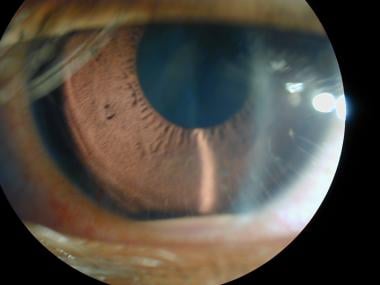Background
Approximately 6% of all cases of uveitis arise in children. [1] The most frequent cause of chronic intraocular inflammation among children is juvenile idiopathic arthritis (JIA)-associated uveitis. [2] A unifying classification, juvenile idiopathic arthritis (JIA), encompassing juvenile chronic arthritis and juvenile rheumatoid arthritis (JRA), has been developed by consensus.
Chronic iridocyclitis occurs in 10-20% of all patients with JIA. [3, 4, 5, 6] Chronic uveitis characteristically is asymptomatic in children with JIA, leading to insidious but progressive morbidity and possible blindness. The involved eyes often are white and quiet appearing, yet 30-40% of patients with JIA-associated uveitis experience severe loss of vision as a consequence of their condition.
JIA, as defined by the American Rheumatism Association (ARA), is the presence of arthritis (chronic, seronegative, and peripheral) before age 16 years, of at least 3 months duration, when other causes have been excluded. It is classified by 1 of 3 types of onset. [7]
Oligoarticular (pauciarticular) onset JIA (40-60%) is common in girls (5:1). Peak age of onset is at age 2 years. Four or fewer joints are involved during the first 6 months of the disease (often asymmetric). Oligoarticular onset commonly involves the knees and, less frequently, the ankles and wrists. The arthritis may be evanescent, rarely destructive, and radiologically insignificant. Approximately 75% of these patients test positive for antinuclear antibody (ANA). This mode of onset rarely is associated with systemic signs. A high risk for uveitis exists. [8]
Polyarticular onset JIA (20-40%) is common in girls (3:1). Peak age of onset is at age 3 years. It involves 5 or more joints during the first 6 months of the disease. Polyarticular onset JIA commonly involves the small joints of the hand and, less frequently, the larger joints of the knee, ankle, or wrist. Asymmetric arthritis may be acute or chronic and may be destructive in 15% of patients. Immunoglobulin M (IgM) rheumatoid factor (RF) is present in 10% of children with this JIA subgroup. It is associated with subcutaneous nodules, erosions, and a poor prognosis. Approximately 40% of these patients test positive for ANA. Systemic symptoms, including anorexia, anemia, and growth retardation, are moderate. An intermediate risk for uveitis exists.
Systemic onset JIA (10-20%) is equal frequency in boys and girls and can appear at any age. Symmetric polyarthritis is present and may be destructive in 25% of patients. Hands, wrists, feet, ankles, elbows, knees, hips, shoulders, cervical spine, and jaw may be involved. ANA is positive in only 10% of the patients. Systemic onset is associated with fever (high in evening and normal in morning), macular rash, leukocytosis, lymphadenopathy, and hepatomegaly. Pericarditis, pleuritis, splenomegaly, and abdominal pain less commonly are observed. A low risk for uveitis exists.
Pathophysiology
The cause of uveitis and arthritis in JIA remains unknown. [9] Akin to many other autoimmune diseases, the target antigen is unidentified. Immune reactions to ocular antigens (S antigen or iris antigen) have been studied; however, their actual role (active or passive) is unknown. The course of the disease may be short and limited or progressive and severe.
Epidemiology
United States
JIA has an estimated prevalence of about 113 cases per 100,000 children. It is estimated that JIA afflicts 60,000-70,000 children, but only a minority develop eye disease. Incidence of eye disease in the JIA population is uncertain, but it is believed to be around 10%. [7]
Mortality/Morbidity
Morbidity in JIA-associated uveitis may result either from lack of treatment or from overzealous treatment. Mortality may result from the latter.
Race
No known racial predilection exists.
Sex
A strong predilection exists for girls. The girl-to-boy ratio is 4:1.
Age
JIA is a childhood disease.
By definition, JIA occurs in children younger than age 16 years.
In view of the fact that the ocular disease can follow the systemic disease by numerous years, a lot of patients are well beyond their teens when they are examined and treated for uveitis. [10]
Prognosis
Most vision-threatening morbidities in JIA are secondary to intraocular inflammation (eg, severity, chronicity). The development of JIA-associated uveitis heralds a poor prognosis.
Of affected eyes, 30-40% maintain long-term acuity greater than 20/40. Conversely, approximately 30-40% develop severe visual disability with acuity less than 20/200.
Poor prognosticators (higher risk for chronic iridocyclitis) include the following [11, 12] :
-
Female sex
-
Early onset pauciarticular arthritis–JIA, as follows:
Young age at disease onset
Pauciarticular arthritis
-
ANA - Positive
-
Others, as follows:
Posterior synechiae
Secondary glaucoma
Patient Education
Patients (and relatives) with JIA-associated uveitis require a significant amount of education regarding the signs and symptoms of disease exacerbation. Emphasize the need for lifestyle changes to prevent exacerbations, preserve vision, and for appropriate pain control.
The need to maintain regular eye visits to check for ocular activity cannot be overemphasized if one is to preserve the patient's remaining useful vision.
Biologics (infliximab, adalimumab, tocilizumab, etc.) have provided new options in the medical management of JIA.
For excellent patient education resources, see eMedicineHealth's patient education articles Juvenile Rheumatoid Arthritis and Rheumatoid Arthritis Medications.
-
Acute anterior uveitis with hypopyon in a child. Courtesy of Manolette Roque, MD, Roque Eye Clinic.
-
Juvenile idiopathic arthritis uveitis. Band keratopathy. Courtesy of Manolette Roque, MD, Roque Eye Clinic.
-
Juvenile idiopathic arthritis uveitis. Pseudophakia with posterior chamber intraocular lens with anterior membrane and posterior capsular opacification with cyclitic membrane formation. Courtesy of Manolette Roque, MD, Roque Eye Clinic.
-
Juvenile idiopathic arthritis uveitis. Use of Grieshaber iris hooks to create and maintain a large enough pupil for adequate visualization during membranectomy and pars plana vitrectomy in a pseudophakic child. The intraocular lens was clear after the anterior lenticular membrane was peeled off. Courtesy of Manolette Roque, MD, Roque Eye Clinic.





